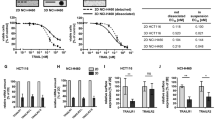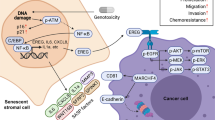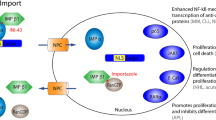Abstract
The cytokine scatter factor/hepatocyte growth factor (HGF/SF) protects epithelial, carcinoma, and other cell types against cytotoxicity and apoptosis induced by DNA-damaging agents such as ionizing radiation and adriamycin (ADR, a topoisomerase IIα inhibitor). We investigated the role of nuclear factor kappa B (NF-κB) signaling in HGF/SF-mediated protection of human prostate cancer (DU-145) and Madin–Darby canine kidney (MDCK) epithelial cells against ADR. HGF/SF caused the rapid nuclear translocation of the p65 (RelA) subunit of NF-κB associated with the transient loss of the inhibitory subunit IκB-α. Exposure to HGF/SF caused the activation of an NF-κB luciferase reporter that was blocked or attenuated by the expression of a mutant ‘super-repressor’ IκB-α. Electrophoretic mobility shift assay supershift assays revealed that HGF/SF treatment induced the transient binding of various NF-κB family proteins (p65, p50, c-Rel, and RelB) with radiolabeled NF-κB-binding oligonucleotides. The HGF/SF-mediated protection of DU-145 and MDCK cells against ADR (demonstrated using MTT (3-(4,5-dimethylthiazol-2-yl)-2,5-diphenyltetrazolium bromide) assays) was abrogated by the IκB-α super-repressor. The ability of HGF/SF to activate NF-κB signaling was dependent on c-Akt → Pak1 (p21-associated kinase-1) signaling (with Pak1 downstream of c-Akt) and was inhibited by the tumor suppressor PTEN (phosphatase and tensin homolog). Inhibitors of phosphatidylinositol-3′-kinase and Src family kinases significantly inhibited HGF/SF-mediated activation of NF-κB, while inhibitors of MEK, protein kinase C, and p70 S6 kinase had a modest effect or no effect on NF-κB activity. HGF/SF induced the expression of several known NF-κB target genes (cIAP-1 (cellular inhibitor of apoptosis-1), cIAP-2, and TRAF-2 (TNF receptor-associated factor-2)) in an NF-κB-dependent manner; HGF/SF blocked the inhibition of expression of these genes by ADR. Experimental manipulation of expression of these genes suggests that they (particularly TRAF-2 and cIAP-2) contribute to the protection against ADR by HGF/SF. These findings suggest that HGF/SF activates NF-κB through a c-Akt → Pak1 signaling pathway that is also dependent on Src, and that NF-κB contributes to HGF/SF-mediated protection against ADR.
This is a preview of subscription content, access via your institution
Access options
Subscribe to this journal
Receive 50 print issues and online access
$259.00 per year
only $5.18 per issue
Buy this article
- Purchase on Springer Link
- Instant access to full article PDF
Prices may be subject to local taxes which are calculated during checkout











Similar content being viewed by others
References
Adam L, Vadlamudi R, Mandal M, Chernoff J and Kumar R . (2000). J. Biol. Chem., 275, 12041–12050.
Alley MC, Scudiero DA, Monks A, Hursey ML, Czerwinski MJ, Fine DL, Abbott BJ, Mayo JG, Shoemaker RH and Boyd MR . (1988). Cancer Res., 48, 589–601.
Amicone L, Spagnoli FM, Spath G, Giordano S, Tommasini C, Bernardini S, De Luca V, Della Roca C, Weiss MC, Comoglio PM and Tripoldi M . (1997). EMBO J., 16, 495–503.
Andrews NC and Faller DV . (1991). Nucleic Acids Res., 19, 2499.
Bardelli A, Longatti P, Albero D, Goruppi S, Schneider C, Ponzetto C and Comoglio PM . (1996). EMBO J., 15, 6205–6212.
Bell S, Degitz K, Quirling M, Jilg N, Page S and Brand K . (2003). Cell Signal., 15, 1–7.
Bottaro DP, Rubin JS, Faletto DL, Chan AM-L, Kmiecik TE, Vande Woude GF and Aaronson SA . (1991). Science, 251, 802–804.
Bouzahzah B, Albanese C, Ahmed F, Pixley F, Lisanti MP, Segall JD, Condeelis J, Joyce D, Minden A, Der CJ, Chan A, Symons M and Pestell RG . (2001). Mol. Med., 7, 816–830.
Bowers DC, Fan S, Walter K, Abounder R, Williams JA, Rosen EM and Laterra J . (2000). Cancer Res., 60, 4277–4283.
Brockman JA, Scherer DC, McKinsey TA, Hall SM, Qi X, Lee WY and Ballard DW . (1995). Mol. Cell. Biol., 15, 2809–2818.
Carter AB and Hunninghake GW . (2000). J. Biol. Chem., 275, 27858–27864.
Cong LN, Chen H, Li Y, Zhou L, McGibbon MA, Taylor SI and Quon MJ . (1997). Mol. Endocrinol., 11, 1881–1890.
Davis ME, Grumbach IM, Fukai T, Cutchins A and Harrison DG . (2004). J. Biol. Chem., 279, 163–168.
DeMeester SL, Buchman TG and Cobb JP . (2001). FASEB J., 15, 270–274.
Deveraux QL, Roy N, Stennicke HR, Van Arsdale T, Zhou Q, Srinivasula SM, Alnemri ES, Salvesen GS and Reed JC . (1998). EMBO J., 17, 2215–2223.
Egan SE and Weinberg RA . (1993). Nature, 365, 781–783.
Fan C, Li Q, Ross D and Engelhardt JF . (2003). J. Biol. Chem., 278, 2072–2080.
Fan S, Ma YX, Gao M, Yuan RQ, Meng Q, Goldberg ID and Rosen EM . (2001). Mol. Cell. Biol., 21, 4968–4984.
Fan S, Ma YX, Wang J-A, Yuan R-Q, Meng Q, Laterra JJ, Goldberg ID and Rosen EM . (2000). Oncogene, 19, 2212–2223.
Fan S, Wang J-A, Yuan R-Q, Rockwell S, Andres J, Zlatapolskiy A, Goldberg ID and Rosen EM . (1998). Oncogene, 17, 131–141.
Foryst-Ludwig A and Naumann M . (2000). J. Biol. Chem., 275, 39779–39785.
Frisch SM and Francis H . (1994). J. Cell Biol., 124, 619–626.
Frost JA, Swantek JL, Stippec S, Yin MJ, Gaynor R and Cobb MH . (2000). J. Biol. Chem., 275, 19693–19699.
Gao M, Fan S, Goldberg ID, Laterra J, Kitsis RN and Rosen EM . (2001). J. Biol. Chem., 276, 47257–47265.
Georgescu MM, Kirsch KH, Akagi T, Shishido T and Hanafusa H . (1999). Proc. Natl. Acad. Sci. USA, 96, 10182–10187.
Guiet C, Silvestri E, De Smaele E, Franzoso G and Vito P . (2002). Cell Death Differ., 9, 138–144.
Gupta S . (2003). Int. J. Oncol., 22, 15–20.
Hakak Y, Sheng Y and Martin GS . (2000). Oncogene, 19, 3164–3171.
Habelhah H, Frew IJ, Laine A, Janes PW, Relaix F, Sassoon D, Bowtell DD and Ronai Z . (2002). EMBO J., 21, 5756–5765.
Hayden MS and Ghosh S . (2004). Genes Dev., 18, 2195–2224.
Hellerbrand C, Jobin C, Licato LL, Sartor RB and Brenner DA . (1998). Am. J. Physiol., 275, G269–G278.
Janssen-Heininger YM, Macara I and Mossman BT . (1999). Am. J. Respir. Cell. Mol. Biol., 20, 942–952.
Jiang B, Xu S, Hou X, Pimentel DR, Brecher P and Cohen RA . (2004). J. Biol. Chem., 279, 1323–1329.
Jin L, Fuchs A, Schnitt SJ, Yao Y, Joseph A, Lamszus K, Park M, Goldberg ID and Rosen EM . (1997). Cancer, 79, 749–760.
Kawamata S, Hori T, Imura A, Takaori-Kondo A and Uchiyama T . (1998a). Proc. Natl. Acad. Sci. USA, 95, 565–569.
Kawamata S, Hori T, Imura A, Takaori-Kondo A and Uchiyama T . (1998b). J. Biol. Chem., 273, 5808–5814.
Kurland JF, Voehringer DW and Meyn RE . (2003). J. Biol. Chem., 278, 32465–32470.
Lee SY, Kaufman DR, Mora AL, Santana A, Boothby M and Choi Y . (1998). J. Exp. Med., 188, 1381–1384.
Lee SY, Reichlin A, Santana A, Sokol KA, Nussenzweig MC and Choi Y . (1997). Immunity, 7, 703–713.
Liu R, Aupperle K and Terkeltaub R . (2001). J. Leukocyte Biol., 70, 961–968.
Magnani M, Crinelli R, Bianchi M and Antonelli A . (2000). Curr. Drug Targets, 1, 387–399.
Matteucci E, Modora S, Simone M and Desiderio MA . (2003). Oncogene, 22, 4062–4073.
Micheau O, Lens S, Gaide O, Alevizopoulos K and Tschopp J . (2001). Mol. Cell. Biol., 21, 5299–5305.
Muller M, Morotti A and Ponzetto C . (2002). Mol. Cell. Biol., 22, 1060–1072.
Ostareck-Lederer A, Ostareck DH, Cans C, Neubauer G, Bomsztyk K, Superti-Furga G and Hentze MW . (2002). Mol. Cell. Biol., 22, 4535–4543.
Ozes ON, Mayo LD, Gustin JA, Pfeffer SR, Pfeffer LM and Donner DB . (1999). Nature, 401, 82–85.
Park YC, Ye H, Hsia C, Segal D, Rich RL, Liou HC, Myszka DG and Wu H . (2000). Cell, 101, 777–787.
Peyssonnaux C, Provot S, Felder-Schmittbuhl MP, Calothy G and Eychene A . (2000). Mol. Cell. Biol., 20, 7068–7079.
Rahmani M, Peron P, Weitzman J, Bakiri L, Lardeux B and Bernuau D . (2001). Oncogene, 20, 5132–5142.
Romashkova JA and Makarov SS . (1999). Nature, 401, 86–90.
Ron D, Brasier AR, Wright KA, Tate JE and Habener JF . (1990). Mol. Cell. Biol., 10, 1023–1032.
Rosen EM, Lamszus K, Laterra J, Polverini PJ, Rubin JS and Goldberg ID . (1998). Angiogenesis. Models, Modulators, and Clinical Applications NATO ASI Series, Series A: Life Sciences, Vol. 298. Maragoudaikis ME (ed). Plenum Press: New York, pp. 415–428.
Saijo K, Schmedt C, Su IH, Karasuyama H, Lowell CA, Reth M, Adachi T, Patke A, Santana A and Tarakhovsky A . (2003). Nat. Immunol., 4, 274–279.
Shen BJ, Chang CJ, Lee HS, Tsai WH, Miau LH and Lee SC . (1997). DNA Cell Biol., 16, 703–711.
Sica A, Dorman L, Viggiano V, Cippitelli M, Ghosh P, Rice N and Young HA . (1997). J. Biol. Chem., 272, 30412–30420.
Sizemore N, Lerner N, Dombrowski N, Sakurai H and Stark GR . (2002). J. Biol. Chem., 277, 3863–3869.
Tan P, Fuchs SY, Chen A, Wu K, Gomez C, Ronai Z and Pan ZQ . (1999). Mol. Cell, 3, 527–533.
Wang CY, Mayo MW, Korneluk RG, Goeddel DV and Baldwin Jr AS . (1998). Science, 281, 1680–1683.
Windham TC, Parikh NU, Siwak DR, Summy JM, McConkey DJ, Kraker AJ and Gallick GE . (2002). Oncogene, 21, 7797–7807.
Wu X, Senechal K, Neshat MS, Whang YE and Sawyers CL . (1998). Proc. Natl. Acad. Sci. USA, 95, 15587–15591.
Xia P, Wang L, Moretti PA, Albanese N, Chai F, Pitson SM, D’Andrea RJ, Gamble JR and Vadas MA . (2002). J. Biol. Chem., 277, 7996–8003.
Yang F, Tang E, Guan K and Wang CY . (2003). J. Immunol., 170, 5630–5635.
Yuan R, Fan S, Achary M, Stewart DM, Goldberg ID and Rosen EM . (2001). Cancer Res., 61, 8022–8031.
Zeng Q, Chen S, You Z, Yang F, Carey TE, Saims D and Wang CY . (2002). J. Biol. Chem., 277, 25203–25208.
Acknowledgements
This work was supported, in part, USPHS grants RO1-ES09169 (EMR), RO1-NS43987 (JJL/ EMR), RO1-CA80000 (EMR), RO1-CA82599 (EMR), and R21AA13122 (SF).
Author information
Authors and Affiliations
Corresponding author
Rights and permissions
About this article
Cite this article
Fan, S., Gao, M., Meng, Q. et al. Role of NF-κB signaling in hepatocyte growth factor/scatter factor-mediated cell protection. Oncogene 24, 1749–1766 (2005). https://doi.org/10.1038/sj.onc.1208327
Received:
Revised:
Accepted:
Published:
Issue Date:
DOI: https://doi.org/10.1038/sj.onc.1208327
Keywords
This article is cited by
-
The cytokines HGF and CXCL13 predict the severity and the mortality in COVID-19 patients
Nature Communications (2021)
-
MET targeting: time for a rematch
Oncogene (2020)
-
Targeting c-MET in gastrointestinal tumours: rationale, opportunities and challenges
Nature Reviews Clinical Oncology (2017)
-
Benzyl isothiocyanate inhibits basal and hepatocyte growth factor-stimulated migration of breast cancer cells
Molecular and Cellular Biochemistry (2012)
-
NF-κB addiction and its role in cancer: ‘one size does not fit all’
Oncogene (2011)



